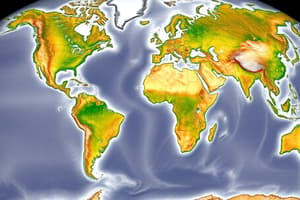Podcast
Questions and Answers
Volcanoes are formed when materials from the Earth's mantle rise to the surface through ______ in the lithosphere.
Volcanoes are formed when materials from the Earth's mantle rise to the surface through ______ in the lithosphere.
cracks
The Juan de Fuca plate is responsible for many of the volcanoes in the ______ Northwest.
The Juan de Fuca plate is responsible for many of the volcanoes in the ______ Northwest.
Pacific
Plates move at a rate of around one to two inches per year, creating three types of tectonic ______: convergent, divergent, and transform.
Plates move at a rate of around one to two inches per year, creating three types of tectonic ______: convergent, divergent, and transform.
boundaries
Volcanic features occur at convergent, divergent, and ______ plate boundaries.
Volcanic features occur at convergent, divergent, and ______ plate boundaries.
Convergent boundaries occur when plates move into one another, leading to the formation of ______ ranges.
Convergent boundaries occur when plates move into one another, leading to the formation of ______ ranges.
Plate tectonics also plays an essential role in the Earth's ______ cycle.
Plate tectonics also plays an essential role in the Earth's ______ cycle.
The idea of continental drift, first proposed by Alfred Wegener in the early 20th century, suggested that our continents had once been connected as a single supercontinent called ______.
The idea of continental drift, first proposed by Alfred Wegener in the early 20th century, suggested that our continents had once been connected as a single supercontinent called ______.
Over time, these massive landmasses separated and drifted across the Earth's ______.
Over time, these massive landmasses separated and drifted across the Earth's ______.
Subduction zones form when one tectonic plate is forced beneath another, driven by the convection currents in the Earth's ______.
Subduction zones form when one tectonic plate is forced beneath another, driven by the convection currents in the Earth's ______.
The San Andreas Fault in California and the Great Rift Valley in Africa are examples of tectonic features shaped by ______ zones.
The San Andreas Fault in California and the Great Rift Valley in Africa are examples of tectonic features shaped by ______ zones.
Flashcards are hidden until you start studying
Study Notes
Exploring Geography, Plate Tectonics, and the Wonders of Earth's Movement
Geography has its roots in the study of Earth's features, processes, and landscapes, and plate tectonics is an essential concept that revolutionizes our understanding of how these elements interact. In this article, we'll delve into the subtopics of continental drift, subduction zones, and volcanoes as they relate to plate tectonics.
Continental Drift: The Wandering Landmasses
The idea of continental drift, first proposed by Alfred Wegener in the early 20th century, suggested that our continents had once been connected as a single supercontinent called Pangaea. Over time, these massive landmasses separated and drifted across the Earth's surface. This theory gained credence when the evidence of matching fossils, rock types, and geologic formations across different continents was discovered.
Subduction Zones: Where Plates Meet and Sink
Subduction zones form when one tectonic plate is forced beneath another, driven by the convection currents in the Earth's mantle. As the cooler, denser plate sinks into the Earth's interior, it melts and releases fluids and volatiles, leading to the formation of volcanoes and mountain ranges. The San Andreas Fault in California and the Great Rift Valley in Africa are examples of tectonic features shaped by subduction zones.
Volcanoes: The Eruption of Earth's Mantle
Volcanoes are formed when materials from the Earth's mantle rise to the surface through cracks in the lithosphere. The Juan de Fuca plate, for instance, is responsible for many of the volcanoes in the Pacific Northwest. These geologic features occur at convergent, divergent, and transform plate boundaries, and they play a significant role in shaping Earth's surface.
Subduction and Plate Movement: Continuing the Cycle
Plates move at a rate of around one to two inches (three to five centimeters) per year. The movement of the plates creates three types of tectonic boundaries: convergent, divergent, and transform. Convergent boundaries occur when plates move into one another, leading to the formation of mountain ranges. Divergent boundaries occur when plates move apart, creating new oceanic crust. Transform boundaries occur when plates move sideways in relation to one another.
Plate Tectonics and the Water Cycle
Plate tectonics also plays an essential role in the Earth's water cycle. As water moves through the oceans and into the atmosphere, over the land, and within the Earth, it dissolves various materials, including rocks and minerals. This cycles minerals locked in the continental crust back into the ocean, and deep in the oceans at subduction zones, water transports these minerals to the Earth's interior.
Conclusion
Plate tectonics provides us with a fascinating insight into the processes that shape our planet. From the formation of continents to the eruption of volcanoes, the interplay of tectonic plates plays a crucial role in the Earth's geography. Understanding these processes allows us to appreciate the beauty and complexity of our world.
Studying That Suits You
Use AI to generate personalized quizzes and flashcards to suit your learning preferences.




